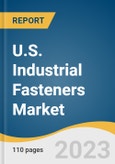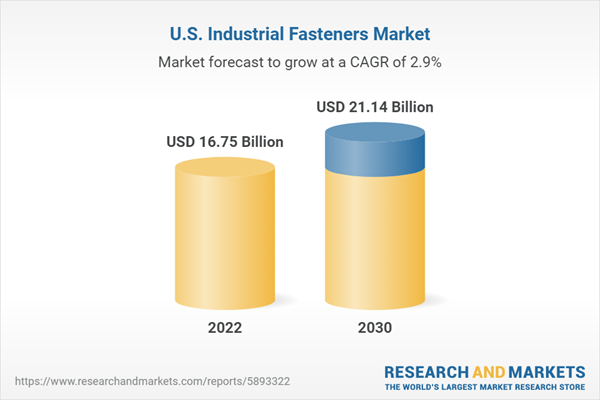The U.S. industrial fasteners market size is anticipated to reach USD 21.14 billion by 2030. The market is projected to grow at a CAGR of 2.9% from 2023 to 2030. The players in the automotive industry are focusing their R&D activities on reducing the overall weight of the vehicles to improve fuel efficiency. Commercial car and LCV manufacturers are continuously striving to reduce the overall vehicle weight and improve reliability, reduce wear, and maintain vehicle strength. Various benefits such as reduced cost, lower weight, and excellent chemical & corrosion resistance offered by plastic fasteners are expected to drive the growth of the industrial fasteners market.
The industrial fastener industry is characterized by intense technological improvements aimed at producing superior and lightweight goods used in automotive and other industrial applications. The manufacturing of fasteners primarily includes casting, forming machining, and thread production processes. The fasteners offered by the major manufacturers in the U.S. comply with the standards including the American Society for Testing and Materials (ASTM), the American Society of Mechanical Engineers (ASME), and the International Organization for Standardization (ISO).
The introduction of laser welding techniques in automobiles has led to an increase in the welding market share. Rising consumption of welds and rivets in various types of aircraft is anticipated to drive the welding market in the aerospace and defense industries, thereby posing a threat to fasteners' market share. Welding is a cost-effective option in steel-intensive construction and is also a preferred choice as it ensures reliability and durability. The ascending utilization of various substitutes in the automotive, aerospace, and construction industries is projected to threaten the growth of the fasteners market in the coming years.
Rising metal costs, combined with increasing demand in other industries such as construction and machine production, are anticipated to influence raw material supply for fasteners. Buyers' bargaining power is likely to expand as demand for plastics with biodegradability, better strength, superior impact, and chemical resistance grows. However, the presence of several raw material suppliers with substantial production volumes is likely to limit raw material providers' dominance. As a result, the bargaining power of suppliers is anticipated to remain low to moderate over the forecast period.
Manufacturers are aiming to achieve optimum business growth and a strong market position through the implementation of various strategies such as acquisition, joint venture, production capacity expansion, new product development, promotion of key product brands, and significant investments in research & development. For instance, in June 2023, CAMCAR announced the acquisition of Ttapdrive AS, the creator of the Ttap brand. The company frequently invests in R&D activities to improve product performance, easy assembling processes, and innovate new fastener products.
The industrial fastener industry is characterized by intense technological improvements aimed at producing superior and lightweight goods used in automotive and other industrial applications. The manufacturing of fasteners primarily includes casting, forming machining, and thread production processes. The fasteners offered by the major manufacturers in the U.S. comply with the standards including the American Society for Testing and Materials (ASTM), the American Society of Mechanical Engineers (ASME), and the International Organization for Standardization (ISO).
The introduction of laser welding techniques in automobiles has led to an increase in the welding market share. Rising consumption of welds and rivets in various types of aircraft is anticipated to drive the welding market in the aerospace and defense industries, thereby posing a threat to fasteners' market share. Welding is a cost-effective option in steel-intensive construction and is also a preferred choice as it ensures reliability and durability. The ascending utilization of various substitutes in the automotive, aerospace, and construction industries is projected to threaten the growth of the fasteners market in the coming years.
Rising metal costs, combined with increasing demand in other industries such as construction and machine production, are anticipated to influence raw material supply for fasteners. Buyers' bargaining power is likely to expand as demand for plastics with biodegradability, better strength, superior impact, and chemical resistance grows. However, the presence of several raw material suppliers with substantial production volumes is likely to limit raw material providers' dominance. As a result, the bargaining power of suppliers is anticipated to remain low to moderate over the forecast period.
Manufacturers are aiming to achieve optimum business growth and a strong market position through the implementation of various strategies such as acquisition, joint venture, production capacity expansion, new product development, promotion of key product brands, and significant investments in research & development. For instance, in June 2023, CAMCAR announced the acquisition of Ttapdrive AS, the creator of the Ttap brand. The company frequently invests in R&D activities to improve product performance, easy assembling processes, and innovate new fastener products.
U.S. Industrial Fasteners Market Report Highlights
- In terms of raw material, polyethylene, polypropylene, polyurethane, polyacrylamide, polystyrene, and nylon are the key raw materials used for manufacturing plastic fasteners. Rising crude oil prices are expected to be a key concern for plastic fastener manufacturers as they directly impact raw material pricing and profit margins. The selection of raw materials is also a key factor for fastener manufacturers as they are required to comply with various safety and regulatory standards laid down by SAE, ISO, ASTM, and ASME
- In terms of product, the externally threaded industrial fasteners were estimated at USD 8.59 billion in 2022. Bolts have a significant market share due to their availability in a wide range of sizes and applications. Various types of bolts available in the market include anchor bolts, carriage bolts, elevator bolts, eye bolts, plow bolts, lag bolts, U-bolts, T-bolts, and structural bolts. Anchor bolts are used to secure structural beams and light poles. Furthermore, they are used to fasten equipment in concrete structures
- In terms of application, the fasteners are essential components used in automobiles. They are offered in a wide range of colors, shapes, and sizes. Automobile fasteners include bolts, nuts, rivets, screws, bits, studs, panel fasteners, and anchors. Metal fasteners have traditionally dominated the market in the United States due to their high tensile strength, and this trend is predicted to continue over the projected period as well
- Technological know-how and an established buyer base are likely to offer major fastener manufacturers a competitive advantage over the small-scale players. The rising need for novel and application-specific fastener designs is expected to open doors for new entrants. Over the projected period, rising raw material prices and high-volume production by established competitors are expected to be major hurdles to new entrants. Over the projected period, the threat of new entrants is expected to be moderate
- A significant percentage of industrial fastener producers are involved in the production of standard fasteners, which are widely accepted by end-use industries, primarily industrial machinery, a few automotive parts, building, and construction. The industry players offering standard industrial fasteners lack in fulfilling the consumer orders when the demand is application-specific and cannot be fulfilled by the standard products offered
Table of Contents
Chapter 1. Methodology and Scope
Chapter 2. Executive Summary
Chapter 3. U.S. Industrial Fasteners Market Variables, Trends & Scope
Chapter 4. U.S. Industrial Fasteners Market: Raw Material Estimates & Trend Analysis
Chapter 5. U.S. Industrial Fasteners Market: Product Estimates & Trend Analysis
Chapter 6. U.S. Industrial Fasteners Market: Application Estimates & Trend Analysis
Chapter 7. Competitive Landscape
List of Tables
List of Figures
Companies Mentioned
- Arconic Fastening Systems and Rings
- Hilti Corporation
- Illinois Tool Works, Inc.
- Acument Global Technologies, Inc.
- ATF, Inc.
- MW Industries, Inc.
- Birmingham Fastener and Supply, Inc.
- SESCO Industries, Inc.,
- Elgin Fastener Group LLC
- Slidematic
Methodology

LOADING...
Table Information
| Report Attribute | Details |
|---|---|
| No. of Pages | 110 |
| Published | September 2023 |
| Forecast Period | 2022 - 2030 |
| Estimated Market Value ( USD | $ 16.75 Billion |
| Forecasted Market Value ( USD | $ 21.14 Billion |
| Compound Annual Growth Rate | 2.9% |
| Regions Covered | United States |
| No. of Companies Mentioned | 10 |









